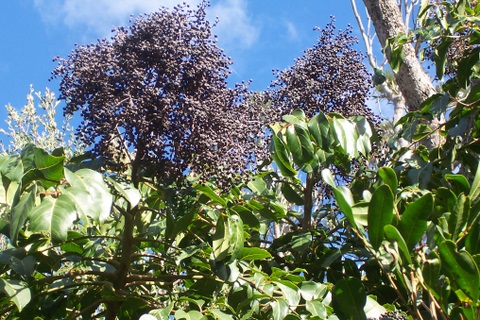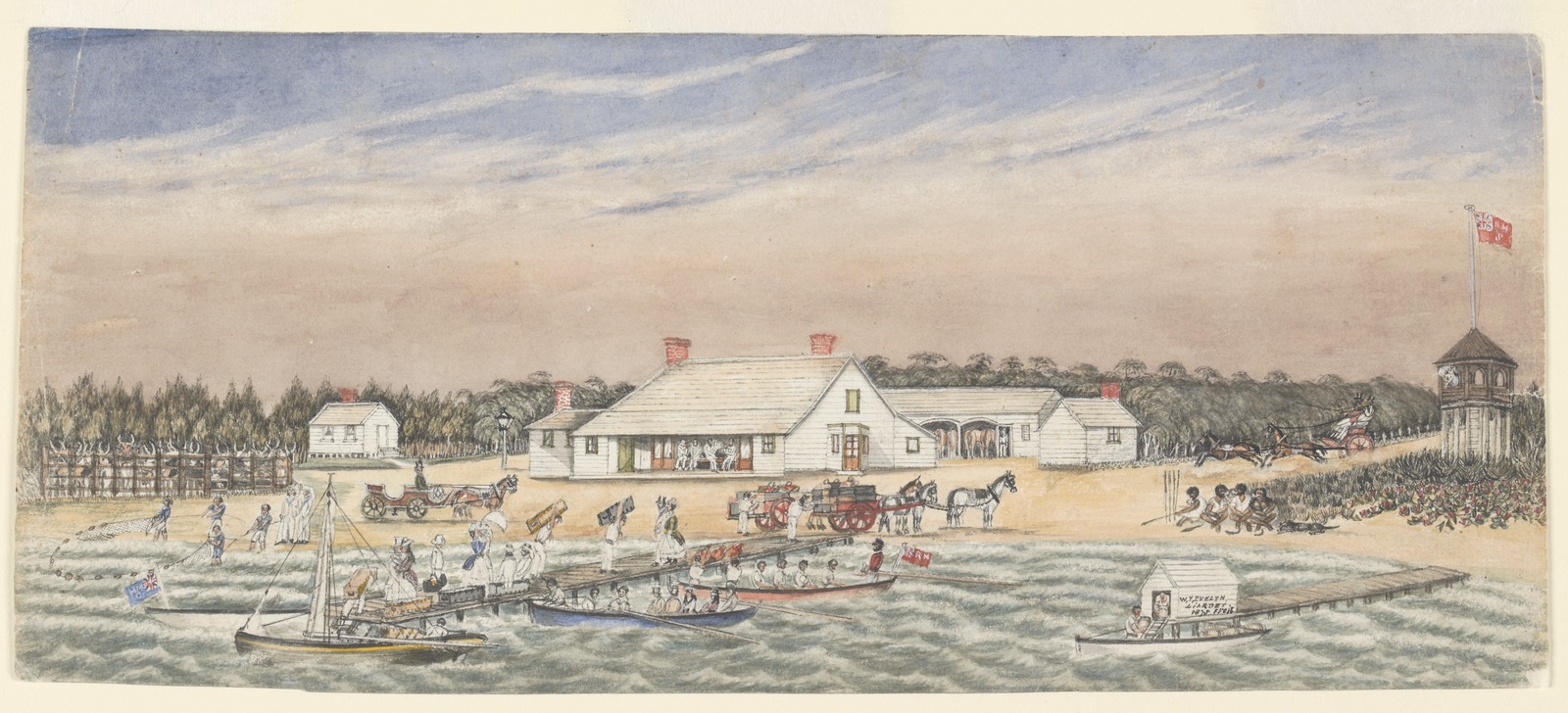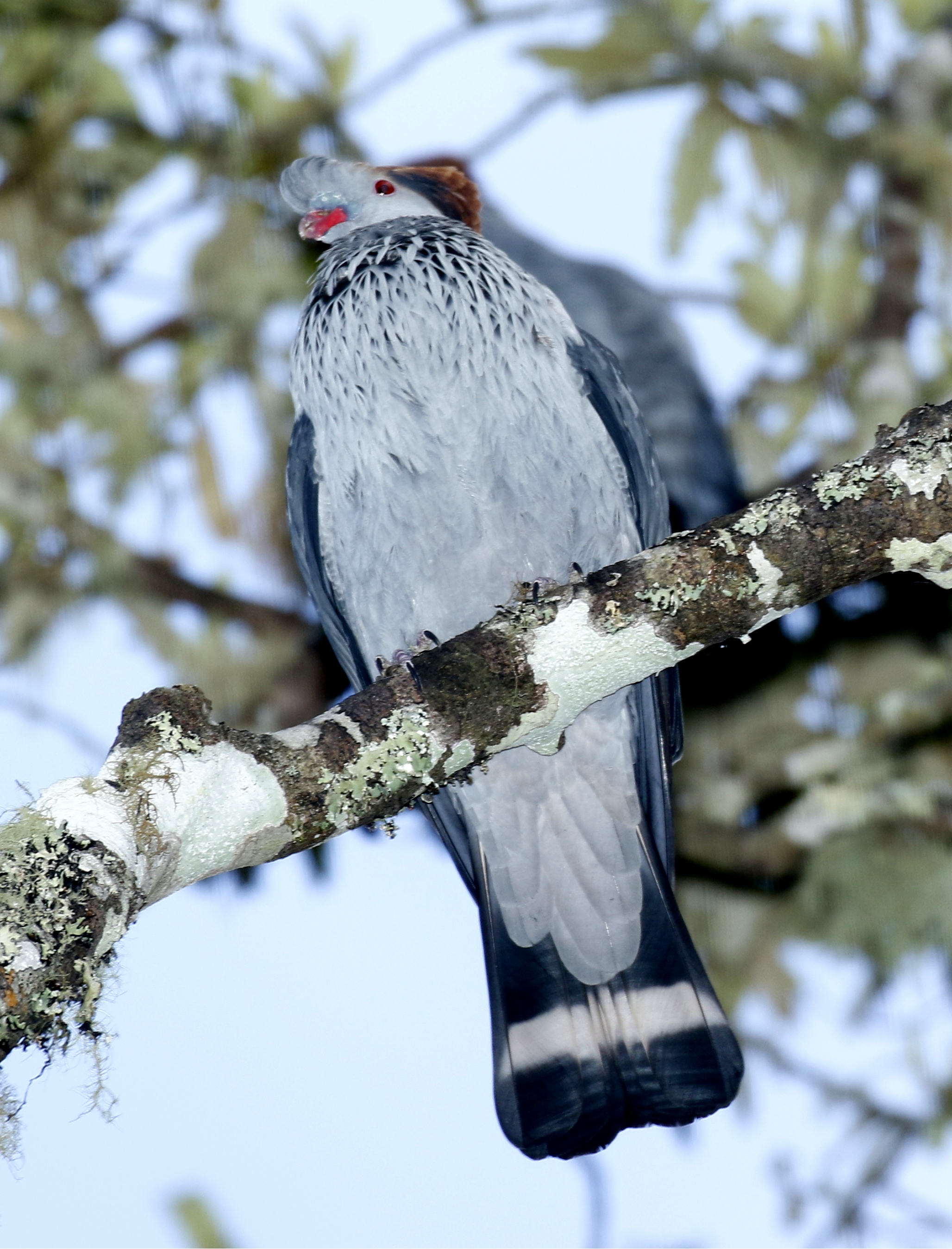|
Polyscias Elegans
''Polyscias elegans'', known as the celery wood, is a rainforest tree of eastern Australia. It occurs in a variety of different rainforest types, from fertile basaltic soils, to sand dunes and less fertile sedimentary soils. The range of natural distribution is from Jervis Bay (35° S) in southern New South Wales to Thursday Island (10° S), north of the Australian continent. Other common names include black pencil cedar and silver basswood. ''Polyscias elegans'' is useful to bush regenerators as a nursery tree, which provides shade for longer-lived young trees underneath. ''Polyscias elegans'' is also known as Celery wood, Mowbulan whitewood, Silver basswood and White sycamore.http://www.plantnames.unimelb.edu.au/Sorting/Polyscias.html Sorting Polyscias names Description It is a fast-growing medium-sized tree with an attractive palm-like or umbrella-shaped crown. Up to 30 meters tall and a trunk diameter of 75 cm. The trunk is mostly straight, unbuttressed and cylin ... [...More Info...] [...Related Items...] OR: [Wikipedia] [Google] [Baidu] |
Wyrrabalong National Park
The Wyrrabalong National Park is a coastal national park that is located on the Central Coast of New South Wales, in eastern Australia. The national park consists of two sections; the northern section consists of approximately and covers a substantial area of the peninsula between The Entrance and Norah Head as well as Terilbah and Pelican Islands within Tuggerah Lake. The southern section consists of about of the coast, from Shelly Beach south to Forresters Beach. The park is also noted for containing the last significant coastal (littoral) rainforest on the Central Coast. Most of the park lies in the Tuggerah Important Bird Area, identified as such by BirdLife International because of its importance for a variety of water and woodland birds. The average elevation of the terrain is 8 meters. History The land now occupied by Wyrrabalong National Park was first inhabited by the indigenous Darkinjung and Awabakal peoples. The Darkinjung occupied the southern section a ... [...More Info...] [...Related Items...] OR: [Wikipedia] [Google] [Baidu] |
Olive-backed Oriole
The olive-backed oriole (''Oriolus sagittatus''), or white-bellied oriole, is a very common medium-sized passerine bird native to northern and eastern Australia and south-central New Guinea. The most wide-ranging of the Australasian orioles, it is noisy and conspicuous. Taxonomy and systematics The olive-backed oriole was originally described in the genus ''Coracias'' by the English ornithologist John Latham in 1801. Subspecies Four subspecies are recognized: * ''O. s. magnirostris'' - van Oort, 1910: Found in south-central New Guinea * ''O. s. affinis'' - Gould, 1848: Originally described as a separate species. Found in north-western and north-central Australia * ''O. s. grisescens'' - Schodde & Mason, IJ, 1999: Found on Cape York Peninsula (north-eastern Australia) and islands of the Torres Strait * ''O. s. sagittatus'' - (Latham, 1801): Found in eastern Australia Description Not bright in colour, it is olive-backed with small dark streaks, with a light chest having blac ... [...More Info...] [...Related Items...] OR: [Wikipedia] [Google] [Baidu] |
Flora Of Queensland
Flora (: floras or florae) is all the plant life present in a particular region or time, generally the naturally occurring ( indigenous) native plants. The corresponding term for animals is ''fauna'', and for fungi, it is '' funga''. Sometimes bacteria and fungi are also referred to as flora as in the terms '' gut flora'' or '' skin flora''. Etymology The word "flora" comes from the Latin name of Flora, the goddess of plants, flowers, and fertility in Roman mythology. The technical term "flora" is then derived from a metonymy of this goddess at the end of the sixteenth century. It was first used in poetry to denote the natural vegetation of an area, but soon also assumed the meaning of a work cataloguing such vegetation. Moreover, "Flora" was used to refer to the flowers of an artificial garden in the seventeenth century. The distinction between vegetation (the general appearance of a community) and flora (the taxonomic composition of a community) was first made by Jules Thu ... [...More Info...] [...Related Items...] OR: [Wikipedia] [Google] [Baidu] |
Flora Of New South Wales ...
*''The Flora that are native to New South Wales, Australia''. :*''Taxa of the lowest rank are always included. Higher taxa are included only if endemic''. *The categorisation scheme follows the World Geographical Scheme for Recording Plant Distributions, in which :* Jervis Bay Territory, politically a Commonwealth of Australia territory, is treated as part of New South Wales; :* the Australian Capital Territory, politically a Commonwealth of Australia territory, is treated as separate but subordinate to New South Wales; :* Lord Howe Island, politically part of New South Wales, is treated as subordinate to Norfolk Island. {{CatAutoTOC New South Wales Biota of New South Wales New South Wales ) , nickname = , image_map = New South Wales in Australia.svg , map_caption = Location of New South Wales in AustraliaCoordinates: , subdivision_type = Country , subdivision_name = Australia , established_title = Before federation , es ... [...More Info...] [...Related Items...] OR: [Wikipedia] [Google] [Baidu] |
Trees Of Australia
The flora of Australia comprises a vast assemblage of plant species estimated to over 30,000 vascular and 14,000 non-vascular plants, 250,000 species of fungi and over 3,000 lichens. The flora has strong affinities with the flora of Gondwana, and below the family level has a highly endemic angiosperm flora whose diversity was shaped by the effects of continental drift and climate change since the Cretaceous. Prominent features of the Australian flora are adaptations to aridity and fire which include scleromorphy and serotiny. These adaptations are common in species from the large and well-known families Proteaceae (''Banksia''), Myrtaceae (''Eucalyptus'' - gum trees), and Fabaceae (''Acacia'' - wattle). The arrival of humans around 50,000 years ago and the settlement by Europeans from 1788, has had a significant impact on the flora. The use of fire-stick farming by Aboriginal people led to significant changes in the distribution of plant species over time, and the large ... [...More Info...] [...Related Items...] OR: [Wikipedia] [Google] [Baidu] |
Apiales Of Australia
The Apiales are an order of flowering plants. The families are those recognized in the APG III system. This is typical of the newer classifications, though there is some slight variation and in particular, the Torriceliaceae may also be divided. Under this definition, well-known members include carrots, celery, parsley, and ''Hedera helix'' (English ivy). The order Apiales is placed within the asterid group of eudicots as circumscribed by the APG III system. Within the asterids, Apiales belongs to an unranked group called the campanulids, and within the campanulids, it belongs to a clade known in phylogenetic nomenclature as Apiidae. In 2010, a subclade of Apiidae named Dipsapiidae was defined to consist of the three orders: Apiales, Paracryphiales, and Dipsacales. Taxonomy Under the Cronquist system, only the Apiaceae and Araliaceae were included here, and the restricted order was placed among the rosids rather than the asterids. The Pittosporaceae were placed within t ... [...More Info...] [...Related Items...] OR: [Wikipedia] [Google] [Baidu] |
Polyscias
''Polyscias'' is a genus of flowering plants in the family Araliaceae. They bear pinnately compound leaves. In 2003, a checklist and nomenclator was published for Araliaceae.David G. Frodin and Rafaël Govaerts. 2003. ''World Checklist and Bibliography of Araliaceae''. Royal Botanic Gardens, Kew. . (See ''External links'' below). In this work, 116 species were listed for ''Polyscias''. , Plants of the World Online recognises 180 species in the genus and 22 synonyms for it. Species A * '' Polyscias aculeata'' * '' Polyscias acuminata'' * ''Polyscias aemiliguineae'' * '' Polyscias aequatoguineensis'' * '' Polyscias aherniana'' * '' Polyscias albersiana'' * '' Polyscias alternifolia'' * '' Polyscias amplifolia'' * '' Polyscias anacardium'' * '' Polyscias andraerum'' * '' Polyscias angustifolia'' * '' Polyscias ariadnes'' * '' Polyscias ashtonii'' * '' Polyscias aubrevillei'' * '' Polyscias australiana'' B * '' Polyscias baehniana'' * '' Polyscias balansae'' ... [...More Info...] [...Related Items...] OR: [Wikipedia] [Google] [Baidu] |
Port Melbourne, Victoria
Port Melbourne is an inner-city suburb in Melbourne, Victoria, Australia, south-west of Melbourne's Central Business District, located within the Cities of Melbourne and Port Phillip local government areas. Port Melbourne recorded a population of 17,633 at the 2021 census. The area to the north of the West Gate Freeway is located within the City of Melbourne, with The area to the south located within the City of Port Phillip. The suburb is bordered by the shores of Hobsons Bay and the lower reaches of the Yarra River. Port Melbourne covers a large area, which includes the distinct localities of Fishermans Bend, Garden City and Beacon Cove. Historically it was known as Sandridge and developed as the city's second port, linked to the nearby Melbourne CBD. The formerly industrial Port Melbourne has been subject to intense urban renewal over the past three decades. As a result, Port Melbourne is a diverse and historic area, featuring industrial and port areas along the Yarra, ... [...More Info...] [...Related Items...] OR: [Wikipedia] [Google] [Baidu] |
Elsevier
Elsevier () is a Dutch academic publishing company specializing in scientific, technical, and medical content. Its products include journals such as '' The Lancet'', '' Cell'', the ScienceDirect collection of electronic journals, '' Trends'', the '' Current Opinion'' series, the online citation database Scopus, the SciVal tool for measuring research performance, the ClinicalKey search engine for clinicians, and the ClinicalPath evidence-based cancer care service. Elsevier's products and services also include digital tools for data management, instruction, research analytics and assessment. Elsevier is part of the RELX Group (known until 2015 as Reed Elsevier), a publicly traded company. According to RELX reports, in 2021 Elsevier published more than 600,000 articles annually in over 2,700 journals; as of 2018 its archives contained over 17 million documents and 40,000 e-books, with over one billion annual downloads. Researchers have criticized Elsevier for its high profit ma ... [...More Info...] [...Related Items...] OR: [Wikipedia] [Google] [Baidu] |
Wompoo Fruit Dove
The wompoo fruit dove (''Ptilinopus magnificus''), also known as wompoo pigeon, is one of the larger fruit doves native to New Guinea and eastern Australia. Taxonomy and systematics Subspecies There are generally 7-8 recognised subspecies, although some authorities recognise as few as 5. * ''P. m. magnificus – Temminck, 1827:'' * ''P. m. keri – :'' * ''P. m. alaris – :'' * ''P. m. assimilis – :'' * ''P. m. poliura – :'' * ''P. m. interposita – :'' * ''P. m. septentrionalis – :'' * ''P. m. puella – :'' Description This dove measures up to , but are generally far smaller in northern regions. It has purple plumage around its neck, chest and upper belly. Its lower belly is yellow and it has green underparts. The sexes are similar and the juveniles have a duller and greener plumage compared to adults. Notwithstanding their bright plumage, they are hard to see amongst the forest canopy, thanks to their unobtrusive, quiet habits. Their call sounds like ''wolla ... [...More Info...] [...Related Items...] OR: [Wikipedia] [Google] [Baidu] |
Topknot Pigeon
The topknot pigeon (''Lopholaimus antarcticus'') is a pigeon native to eastern Australia. Taxonomy English naturalist George Shaw described the topknot pigeon as ''Columba antarctica'' in 1793. The topknot pigeon is sister taxon to a lineage that gave rise to the mountain pigeons (''Gymnophaps'') of New Guinea, the common ancestor of both diverged from a lineage that gave rise to the kereru and Chatham pigeon. "Topknot pigeon" has been designated the official common name by the International Ornithologists' Union (IOC); John Gould noted in 1848 that it had been given this name by the colonists of New South Wales. It is also known by the name of "flock pigeon". Description The topknot pigeon is a large predominately slate-grey bird, in length. The back, coverts and upper secondaries are a darker slate-grey with black quills. The primaries are black, the remaining body in a lighter slate-grey in colour. The chest and hind neck are notched, showing dark bases giving a str ... [...More Info...] [...Related Items...] OR: [Wikipedia] [Google] [Baidu] |
Superb Fruit Dove
The superb fruit dove (''Ptilinopus superbus''), also known as the purple-crowned fruit dove (leading to easy confusion with the purple-capped fruit dove), is a medium-sized (22–24 cm long), colourful fruit-dove in the family Columbidae. Description It is sexually dimorphic. Males are superbly coloured with a fiery orange nape, green ears, and a purple crown. The breast is grey, and divided from the abdomen by a wide, dark blue band. Their wings are olive green covered with dark spots, and the tail is tipped with white. Females are mostly green, with a white abdomen, blue wing tips, light blue breast, and a small, dark blue spot on the back of the head. Both sexes have yellow eyes and eye-rings. Despite its colourful plumage, the superb fruit dove is well-camouflaged amongst the rainforest foliage. Range Native to Australasia, the superb fruit dove lives in the rainforests of New Guinea, Australia, Solomon Islands, the Philippines and Sulawesi of Indonesia. In Austra ... [...More Info...] [...Related Items...] OR: [Wikipedia] [Google] [Baidu] |






